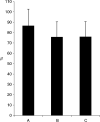Association of perceived physician communication style with patient satisfaction, distress, cancer-related self-efficacy, and perceived control over the disease
- PMID: 12618870
- PMCID: PMC2376357
- DOI: 10.1038/sj.bjc.6600798
Association of perceived physician communication style with patient satisfaction, distress, cancer-related self-efficacy, and perceived control over the disease
Abstract
The aim of the study was to investigate the association of physician communication behaviours as perceived by the patient with patient reported satisfaction, distress, cancer-related self-efficacy, and perceived control over the disease in cancer patients. Questionnaires measuring distress, self-efficacy, and perceived control were completed prior to and after the consultation by 454 patients attending an oncology outpatient clinic. After the consultation, the patients also rated the physicians' communicative behaviours by completing a patient-physician relationship inventory (PPRI), and the physicians were asked to estimate patient satisfaction. The overall results showed that higher PPRI scores of physician attentiveness and empathy were associated with greater patient satisfaction, increased self-efficacy, and reduced emotional distress following the consultation. In contrast, lower PPRI scores were associated with reduced ability of the physician to estimate patient satisfaction. The results confirm and expand previous findings, suggesting that communication is a core clinical skill in oncology.
Figures




References
-
- Avis M, Bond M, Arthur A (1995) Satisfying solutions? A review of some unresolved issues in the measurement of patient satisfaction. J Adv Nurs 22: 316–322 - PubMed
-
- Baile WF Lenzi R, Kudelka AP, Maguire P, Novack D, Goldstein M, Myers EG, Bast Jr RC (1997) Improving physician–patient communication in cancer care: outcome of a workshop for oncologists. J Cancer Educ 12: 166–173 - PubMed
-
- Bandura A (1997) Self-efficacy – The Exercize of Control. New York: Freeman and Company
-
- Butow PN, Dunn SM, Tattersall MH, Jones QJ (1994) Patient participation in the cancer consultation: evaluation of a question prompt sheet. Ann Oncol 5: 199–204 - PubMed
-
- Cantwell BM, Ramirez AJ (1997) Doctor–patient communication: a study of junior house officers. Med Educ 31: 17–21 - PubMed
Publication types
MeSH terms
LinkOut - more resources
Full Text Sources
Medical

